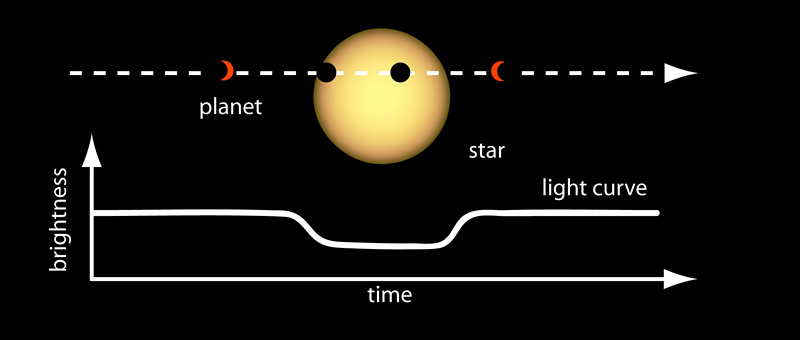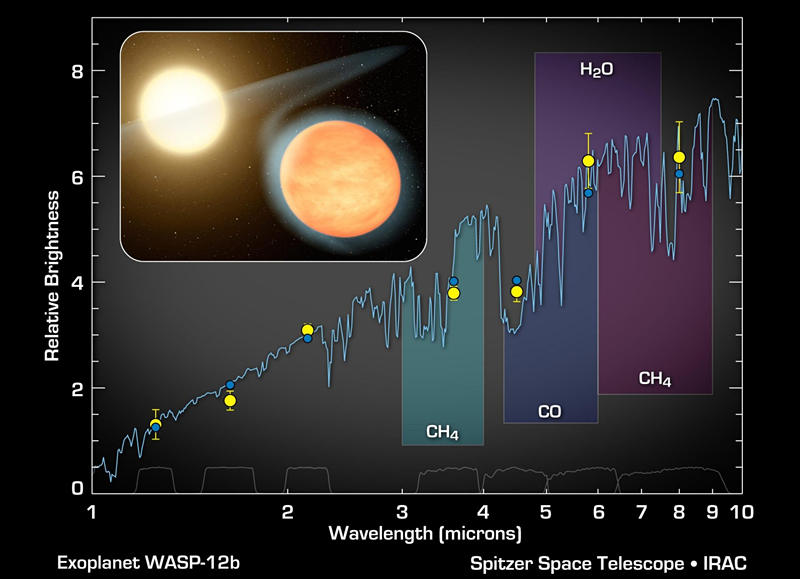WASP-12b, a hot Jupiter discovered orbiting the star WASP-12, stands as an intriguing celestial phenomenon that has captivated the attention of astronomers since its identification on April 1, 2008, through the SuperWASP planetary transit survey. Positioned at a mere 1/43rd of the Earth’s distance from the Sun, this exoplanet completes an orbit around its star in just over a single Earth day, showcasing a stark contrast to our planet’s annual journey around the Sun. The proximity of WASP-12b to its host star, combined with its unique characteristics, has marked it as a valuable subject for planetary research.
The allure of WASP-12b extends beyond its rapid orbit; it absorbs a staggering 94% of the light that reaches its surface, resulting in an exceptionally low albedo. Notably, the Hubble Space Telescope detected water in its atmosphere in 2013, contributing to the growing body of knowledge about exoplanetary compositions. Furthermore, recent observations in 2017 revealed that WASP-12b reflects only 6% of the incident light, rendering it as dark as asphalt. This beguiling darkness, coupled with the planet’s peculiar features, prompts us to delve deeper into the mysteries surrounding this celestial body.
As we explore WASP-12b, questions arise regarding its atmospheric dynamics, heat distribution, and the remarkable fact that it is being tidally distorted into an egg shape by the gravitational forces of its host star. The perpetual facing of the same side towards the star, characteristic of hot Jupiter exoplanets, induces strong winds and intriguing temperature differentials. Additionally, the ongoing tidal heating and the planet’s extreme proximity contribute to surface temperatures exceeding 2,500 K (2,200 °C).
This study aims to unravel the complexities of WASP-12b, addressing pivotal questions such as the nature of its atmosphere, the dynamics of its orbital decay, and the implications of its carbon-rich composition. By examining its characteristics and behavior, we endeavor to contribute valuable insights to the broader field of planetary science, shedding light on the diverse and extraordinary nature of exoplanets.
Unveiling the Fate of WASP-12b: A Hot Jupiter’s Captivating Journey Toward Destruction
WASP-12b, categorized as a “hot Jupiter,” presents captivating features that make it a focal point in planetary exploration. Situated 600 light-years away in the Auriga constellation, this colossal gas giant exhibits distinctive qualities, including its mass, radius, and orbital characteristics. The planet’s rapid orbit around its host star, WASP-12, completing a revolution in just 26 hours, starkly contrasts with the leisurely orbits of Earth and our neighboring planets.

The uniqueness of WASP-12b extends to its atmospheric composition and temperature, showcasing traits typical of a hot Jupiter. With a surface temperature exceeding 2500K (2200°C), it absorbs a staggering 94% of incident light, distinguishing it as an absorbing giant among exoplanets. Furthermore, in December 2013, scientists utilizing the Hubble Space Telescope reported the detection of water in the planet’s atmosphere, enriching our understanding of its composition.
However, this planetary marvel is not destined for eternal existence but rather a poignant spiral toward destruction. Led by a team from Princeton University, astrophysicists revealed in a paper published on December 27, 2019, in the Astrophysical Journal Letters that WASP-12b is spiraling inexorably toward its host star, facing obliteration in approximately 3 million years. The tidal interactions between the planet and its star induce this spiral phenomenon, providing crucial insights into stellar interior structures.
This discovery not only contributes to deciphering the evolution and fate of exoplanetary systems but also imparts valuable information about the lifetimes of hot Jupiters. The unraveling of this orbital decay process sheds light on the enigmatic formation of these unusual planets, enriching the realm of planetary science with newfound perspectives.
WASP-12b’s Enigmatic Darkness: Unraveling the “Black as Asphalt” Mystery
One of the most captivating aspects of WASP-12b, the hot Jupiter located approximately 600 light-years away in the Auriga constellation, is its peculiar and enigmatic appearance—described as “black as asphalt.” This striking characterization stems from the planet’s astonishingly low albedo, the measure of reflected light.
WASP-12b’s albedo is notably minimal, with the planet absorbing a staggering 94% of the light that strikes its surface. This exceptional property sets it apart as one of the darkest known exoplanets, prompting comparisons to the deep blackness of asphalt. The question arises: What mechanisms contribute to this intense light absorption, rendering WASP-12b darker than most other celestial bodies?
The proximity of WASP-12b to its host star, WASP-12, plays a pivotal role in this cosmic phenomenon. Situated at a mere 1/43rd of Earth’s distance from the Sun, the scorching irradiation from its star bathes the planet in an intense flux of energy. As a result, WASP-12b experiences tidal locking, with one side perpetually facing the star and the other plunged into perpetual darkness.

This extreme proximity not only subjects the planet to intense tidal forces, distorting it into an egg shape but also induces a remarkable flow of heat from the illuminated side to the cooler, perpetually dark side. This intricate dance of thermal energy is thought to generate powerful winds rushing across the planet’s atmosphere. The day side, bombarded by the relentless stellar radiation, becomes highly heated, causing hydrogen to ionize. As the winds carry the ionized hydrogen to the dark side, it recombines into neutral atoms, enhancing the transport of heat.
Additionally, the planet’s atmosphere undergoes significant distortion due to tidal forces, pulling away its outer layers at a rate of about 10^(-7) MJ per year. This phenomenon, known as “tidal heating,” coupled with the planet’s proximity to its star, contributes to a scorching surface temperature exceeding 2500 K (2200°C).
In September 2017, observations by the Hubble Space Telescope revealed that WASP-12b reflects only 6% of the light that reaches its surface. This exceptionally low reflectivity further accentuates its “black as asphalt” appearance, making it one of the darkest exoplanets ever observed.
In conclusion, the extraordinary darkness of WASP-12b, akin to asphalt’s deep blackness, is a consequence of its intimate dance with its host star, tidal locking, and the complex interplay of thermal and radiation dynamics. This cosmic enigma not only adds to the allure of WASP-12b but also provides a unique window into the extreme conditions shaping the atmospheres of hot Jupiters in our vast universe.
Orbital and Stellar Interaction
WASP-12b’s orbit around its host star, WASP-12, is characterized by extreme proximity, completing a full orbit in just over one Earth day. This close proximity, only 1/43 of the Earth’s distance from the Sun, results in intense gravitational interactions between the planet and its host star. The gravitational pulls between the two celestial bodies induce “tides” analogous to ocean tides raised by the moon on Earth.
The tidal forces acting on WASP-12b are substantial, causing the star to become slightly distorted and oscillate. This tidal interaction, fueled by the close orbital proximity, initiates a process known as tidal heating. As tidal waves crash within the star due to friction, the oscillations dissipate, converting the orbital energy of the planet into heat within the star. The associated friction also imparts a gravitational torque on WASP-12b, compelling the planet to spiral inward toward its host star.

The consequences of such a close orbit and tidal interaction extend to the structural integrity of WASP-12b. The tidal forces are so potent that they distort the planet into an egg shape and lead to the gradual loss of its atmosphere at a rate of about 10^-7 MJ per year. This phenomenon, observed through the Hubble Space Telescope, underscores the profound impact of tidal interactions on the physical state of the exoplanet.
Moreover, the misalignment of WASP-12b’s orbit with the equatorial plane of its star, as determined through the Rossiter–McLaughlin effect, contributes to the intricate dynamics of the system. The study from 2019 and its subsequent updates reveal a clear trend of orbital decay. The decreasing time interval between transits and the refined decay rate in 2022 provide robust evidence that WASP-12b is indeed on a spiraling trajectory toward its host star.
The intense gravitational interplay and the resultant tidal forces not only dictate the fate of WASP-12b but also offer a unique opportunity to study the internal workings of stars. By measuring the rate of orbital decay, astrophysicists gain valuable insights into the process of dissipating orbital energy within the star, shedding light on the behavior of stars as fluid bodies.
In conclusion, WASP-12b’s orbit and its intricate dance with its host star illuminate the profound influence of tidal interactions on the dynamics and fate of exoplanets. The proximity-induced tidal forces not only lead to the loss of the exoplanet’s atmosphere but also provide a crucial lens through which we can understand the evolution and lifetimes of hot Jupiters in close orbits around their host stars.
Observational Methods and Data Analysis of WASP-12b
Observing exoplanets like WASP-12b involves employing various advanced techniques to unravel the mysteries surrounding their atmospheres and orbital dynamics. The primary methods utilized in the study of WASP-12b include the transit method and spectral analysis.
The transit method is a crucial observational technique, and WASP-12b was initially discovered using this approach. This method involves monitoring the brightness of a star and detecting periodic dips in brightness as a planet passes in front of it, causing a subtle dimming effect. In the case of WASP-12b, the SuperWASP planetary transit survey, conducted on April 1, 2008, played a pivotal role in its discovery. This method allows astronomers to deduce essential orbital parameters, such as the planet’s orbital period and distance from its host star.

Spectral analysis is another powerful tool employed in studying exoplanets. By scrutinizing the spectrum of light emanating from WASP-12b, scientists can gain valuable insights into its atmospheric composition, temperature, and physical properties. In December 2013, the Hubble Space Telescope (HST) contributed significantly to this endeavor by detecting water molecules in the exoplanet’s atmosphere, enriching our understanding of its composition.
To conduct these observations, sophisticated instruments, including the Hubble Space Telescope and potentially other specialized optical or infrared instruments, were utilized. The HST, equipped with its Cosmic Origins Spectrograph (COS), played a crucial role in studying WASP-12b. The COS allows astronomers to capture high-resolution spectra, enabling detailed analysis of the planet’s atmospheric layers and physical characteristics.
The processing of observational data is a critical aspect of extracting meaningful information. Advanced data processing techniques, including calibration and filtering, are employed to eliminate potential noise and enhance the accuracy of the data. Additionally, when dealing with spectral data, intricate mathematical models and statistical methods are applied to interpret observed spectral features, providing valuable scientific insights.
In conclusion, the combined use of the transit method and spectral analysis, facilitated by advanced instruments like the Hubble Space Telescope with its COS, has enabled scientists to delve deep into the nature of WASP-12b. These observational methods and data analysis techniques contribute to a comprehensive understanding of the exoplanet’s atmospheric composition, orbital characteristics, and pave the way for further exploration of exoplanetary systems beyond our solar system.
Research Findings on WASP-12b
The comprehensive study of WASP-12b has yielded significant insights into various aspects, encompassing its atmospheric composition, planetary formation, and evolution processes. The findings contribute to a deeper understanding of the unique characteristics exhibited by this hot Jupiter.
One key discovery pertains to the atmospheric composition of WASP-12b. The detection of water molecules in its atmosphere, reported on December 3, 2013, using the Hubble Space Telescope (HST), marked a crucial milestone. This revelation enhances our understanding of the exoplanet’s chemical makeup, providing valuable data on its atmospheric constituents. Additionally, the identification of a carbon-rich environment, indicated by an elevated carbon-to-oxygen ratio, suggests a distinctive composition that deviates from the solar norm. The presence of carbon monoxide and methane within its atmosphere, as observed in a 2010 study, adds complexity to our comprehension of exoplanetary atmospheres.

The study also sheds light on the orbital dynamics of WASP-12b. The observation of a highly misaligned orbit, with an inclination of 59+15 −20° to the equatorial plane of its star, emphasizes the unique nature of its orbital configuration. Furthermore, the remarkable revelation of the exoplanet’s orbital decay is a groundbreaking result. The measured decrease in the time interval between transits, updated in 2022 to 29.81±0.94 msec/year, implies a rapid orbital decay with an estimated lifetime of 3.16±0.10 million years. This phenomenon is attributed to tidal interactions between WASP-12b and its host star, providing unprecedented insights into the fate of close-in giant planets.
The importance of these results extends beyond the individual characteristics of WASP-12b. The identification of a carbon-rich gas giant challenges existing planetary formation models and opens avenues for exploring diverse compositions in exoplanetary systems. The rapid orbital decay observed in WASP-12b has broader implications for the understanding of the lifetimes of hot Jupiters and the dynamics of exoplanetary systems. These findings offer a valuable foundation for future studies, guiding researchers in exploring the intricacies of exoplanetary atmospheres and the evolution of planetary systems.
In conclusion, the research on WASP-12b provides a comprehensive and nuanced understanding of this unique hot Jupiter, unveiling intriguing details about its atmosphere, orbital characteristics, and broader implications for planetary science. The results pave the way for further investigations into the rich diversity of exoplanets and the underlying processes that shape their existence.
END:
The investigation into WASP-12b has unveiled a multitude of fascinating phenomena, contributing significantly to our understanding of hot Jupiters and their intricate dynamics. The primary findings encompass the unique atmospheric characteristics, rapid orbital decay, and impending demise of this extraordinary exoplanet.
One of the pivotal outcomes of this research is the revelation of WASP-12b’s atmospheric composition. The detection of water in its atmosphere, reported in 2013, along with the identification of a significantly enhanced carbon-to-oxygen ratio, challenges conventional models of planetary formation. The carbon-rich nature of WASP-12b, resembling a “diamond planet,” introduces a novel dimension to our understanding of exoplanetary diversity.
The observation of WASP-12b’s orbital dynamics provides another key insight. The unprecedented confirmation of orbital decay, with an estimated lifetime of 3.16±0.10 million years, signifies the imminent demise of the exoplanet. The study highlights the role of tidal interactions with its host star, WASP-12, leading to a faster decay compared to other exoplanets.
Furthermore, the research sheds light on the interior workings of stars through the study of gravitational interactions and tidal forces. The measured rate of orbital decay serves as a valuable clue about stars as fluid bodies and opens avenues for understanding the evolution and fate of exoplanetary systems.
In proposing potential future research directions, it is crucial to explore similar systems exhibiting orbital decay. Identifying and studying additional hot Jupiters undergoing this process will enhance our understanding of the broader patterns and timescales involved. Moreover, detailed investigations into the carbon-rich nature of WASP-12b could lead to the discovery of other unique exoplanetary compositions, challenging and refining existing theories.
In conclusion, the study of WASP-12b has not only provided a wealth of information about this particular exoplanet but has also offered broader insights into the diverse nature of planetary systems and the intricate interplay of gravitational forces. The imminent demise of WASP-12b adds a temporal dimension to our understanding of planetary lifetimes, prompting further exploration into the formation and evolution of these enigmatic celestial bodies.
More UFOs and mysterious files, please check out our YouTube channel: MysFiles
Lacerta Files: Human beings are the product of genetic engineering by alien civilizations.








